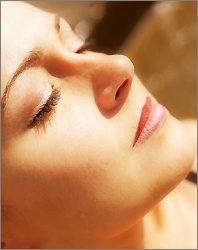Tanning Beds: Why is Science Saying They're Addictive? What are Their Health Benefits and Risks?
by www.SixWise.com
Tanning in the United States is a $2-billion industry, bringing
in more than 1 million indoor tanners every day. What has
caused tanning rates to surge by 300 percent between the 1980s
and 1990s, even though concerns over skin cancer have also
been on the rise?
|

Some Americans may be addicted to tanning -- to the
point where they feel withdrawal symptoms if they go
too long without it.
|
Tanners, as it turns out, may be going to the tanning salon
for more than just a bronze glow. Tanning beds, along with
their potential risks, also offer some health benefits --
and they may also produce a drug-like high.
Getting Hooked on Tanning
It's possible to get "hooked" on tanning much like
it is possible to get hooked on a drug, researchers say. A
new study has lent credence to a 2004 study, which found that
when tanners used two tanning beds (one with real ultraviolet
(UV) light and one without), they felt happier after the UV
light.
"A more relaxed and less tense mood was reported after
UV exposure compared to after non-UV exposure," said
Dr. Steven Feldman, a dermatologist at Wake Forest University.
"We believe these relaxing and reinforcing effects contribute
to tanning behavior and may help explain why people choose
to tan despite the risks."
The new study, conducted by Dr. Mandeep Kaur of Wake Forest
University (who was also involved in the 2004 study), compared
eight frequent tanners (who went tanning eight to 15 times
a month) with infrequent tanners (tanning once a month or
less).
Half of each group was given opiate-blocking drugs, which
blocked endorphins (the "feel-good" brain chemicals)
from producing their pleasurable effects. The frequent tanners
said they got less enjoyment when taking the drugs, which
suggests the pleasant feeling played a role in their desire
to tan.
Interestingly, half the frequent tanners also experienced
withdrawal-type symptoms, including nausea and jitteriness,
when the pleasant feeling was blocked.
Dr. Feldman explained: "Frequent tanning may be driven
in part by a mild dependence on opioids, most likely endorphins.
The nausea and jitteriness ... are consistent with symptoms
of mild opiate withdrawal."
The Health Benefits of Tanning
Relaxation and better mood aside, tanning does offer some
other health benefits that are often overlooked by the mainstream
public (but not by frequent tanners, it turns out).
Most notably, tanning gives the body a chance to produce
vitamin D, a nutrient that has come out as a major player
in fighting everything from cancer to heart disease to depression,
and which many Americans may not be getting enough of.
"Instead of tanning just for cosmetic reasons, an increasing
number of regular tanning bed users have learned that regular,
responsible and moderate exposure to UV light -- from natural
or artificial sources -- is important to well-being, natural
vitamin D production and disease prevention," said tanning
technology researcher Michael Stepp, who is CEO of Wolff System
Technology (a manufacturer of sunlamps for tanning beds).
In circumstances when a person is unable to get out into
natural sunlight, either because of climate or a disability,
some experts say tanning beds may offer a suitable solution
to getting adequate amounts of vitamin D.
|

Whether from sunlight or a tanning bed, overexposure
to UV light can cause wrinkling and loss of elasticity
in the skin.
|
According to a Wolff study, which surveyed 300 men and women
who use commercial indoor tanning beds, "Nearly 55 percent
believe indoor tanning is a responsible way to protect the
skin from overexposure by the sun. These regular tanners recognize
that there is a growing body of validated medical research
pointing to the benefits of UV-generated Vitamin D -- as well
as the serious medical and health risks of chronic sun-deprivation
vitamin D deficiencies."
Tanning Poses Risks, Too
Before heading out to one of the nation's nearly 20,000 tanning
salons, you should be aware that tanning does pose some risks.
According to the World Health Organization (WHO), exposure
to UV light, either from the sun or a tanning bed, is a risk
factor for skin cancer. Short-wavelength UVB light has been
found to be carcinogenic in animals, and longer wavelength
UVA, which penetrates the skin more deeply and is used in
tanning beds, may also contribute to cancer.
Further, a study in Norway and Sweden found that women who
regularly used tanning beds had a greater risk of malignant
melanoma.
Tanning, either from tanning beds or the sun, can also damage
the skin structurally. In the short-term, this can lead to
burning, fragility and scarring. In the long-term, overexposure
to UV can result in photoageing, which occurs when collagen
in the skin is broken down by UV. The end result is wrinkling
and a loss of elasticity.
Eye problems, including cataracts, pterygium (a white-colored
growth over the cornea) and inflammation of the eye can also
occur from UV exposure. Excessive exposure may also suppress
the immune system, potentially leaving a person at risk from
infectious
diseases.
Avid tanners will defend the benefits of tanning just as
intensely as opponents will refute them. As the debate over
tanning ... and its stronghold over many Americans ...
continues, it's up to you to make your own final informed
decision about this activity.
Recommended Reading
LISTEN
UP! Exposure to Loud Noise May Cause Tumor & Other Health
Risks
27
"Never Events": They're Not Supposed to Happen,
but They Often Do
Sources
You
Can Get Hooked on Tanning Because it Gets You High
Frequent
Tanners May be Lured by the "Feel-Good" Effects
of UV Light
Research
Study Profiles Indoor Tanners
WHO:
Sunbeds, Tanning and UV Exposure
Indoor
Tanning Dangers